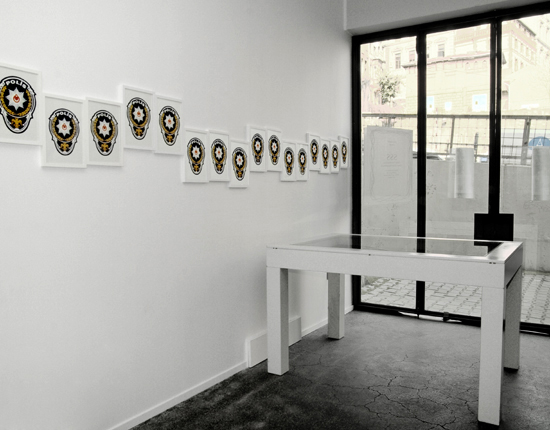
POLIS
Isabel Schmiga is fascinated by the potential for an object or idea to change state, which she then examines and puts into process either literally or figuratively. In many of her works existing objects such as ties, leaves, marbles and forks, or printed images and diagrams are transformed into new, more conceptually complex versions of themselves. But in her work POLIS, her starting point is an extremely specific emblem - it is the Turkish Police badge, a designed composition of imagery that is already a socially and politically charged effigy.
Schmiga's version of this badge in her work POLIS presents an extremely uncanny proposal. Through a layering of a carved relief of the emblem atop the original design, Schmiga draws attention to the badge's eerie skull-like shape: the outline of the skull is already marked out by the symmetrical, aerial view of a police cap that creates the shape of the badge; the double eagle insignia forms a moustache; the crescent moon and star motif an ominous third eye. As in Hans Holbein's The Ambassadors, 1533, the layered representation is rendered as if in anamorphic perspective and only becomes clear when viewed from an angle. As the cut outs appear and their depth gives a slight shadow, a perfect skull appears. In this camouflaged state, the badge, like the police it adorns, amalgamates an aura of protection with an implication of fear.
Schmiga became obsessed by this authoritarian ornament after spending several months living opposite a police guard in Istanbul, Turkey.
For her, the feature of the skull was always present in the shape and detailing of the badge and her double-relief print was made as a response to the image she was seeing all around her. This badge is omnipresent in Turkey, seen on the police uniform, as well as the forces' cars, buses and stations, so its appearance in Schmiga's work is in part due to its being an everyday encounter. For her this badge, as with any other object, was available to be taken and morphed by her personal reflection. So while Schmiga's work POLIS of course refers to a media acknowledged concern about Turkey's police presence, attitude and occasional use of disproportionate force, as well as to a general atmosphere of contradiction and awkwardness that is caused by tensions of group mentality and nationalism, it is also a simple response to a visual slippage created by the shape and design of the badge.
This slippage is then pushed by Schmiga, so that other signs and symbols become more obviously integrated into her interpretation of this emblem. By placing the mouth of the skull in line with the double-eagle motif, she visually replicates a different statement of nationalism, the preference for males to don a moustache. The third-eye is formed by Turkey's flag, suggesting the overriding presence of National authority, but at the same time it is a reference to Islam and the rule of the former Ottoman empire; a combination of associations that can be read as the eye of knowledge, a control of will, or a system of belief, all issues that are very pertinent to the political situation in Turkey today.
When exhibited POLIS consists of a repetitive series of Schmiga's photographic reliefs snugly butted up against one another filling the length of an entire wall. There are never less than five of the framed images presented at one time, a reference to the group presence of the police in Istanbul especially in the central entertainment zone of Istiklal Caddesi. Here police are nearly always present in groups of at least three, and often usually five or more. During public demonstrations or pre-publicised events when the police anticipate their necessity, they often outnumber those they are supposedly protecting, but are in fact waiting to control. In Basel for Schmiga's exhibition in von Bartha Garage, 60 of the badges were positioned in a slightly uneven line hinting at the meagre allowance of individuality given to each member of the formation, as well as the tension felt in numbers and in the expectancy of friction. The skull seen in such prevalence and force also replicates the gas masks often worn prematurely by the police before the potential, or actual release of tear gas, a practice that is not uncommon in the current climate of the city.
Hence for a variety of reasons and on many levels Schmiga's work creates a sense of deja vu for those who live in the vicinity of this badge. As the skull was always there for Schmiga, it is now also always there for those who have experienced her work. Through a simple visual act she has marked a new relationship between the public and their encounter with this particular sign of the police. More importantly her work encourages a more general moment of reflection for us all on society's level of acceptance of forms of power and control in our every day environment.
NOVEMBER PAYNTER
Director, Artist Pension Trust, Dubai